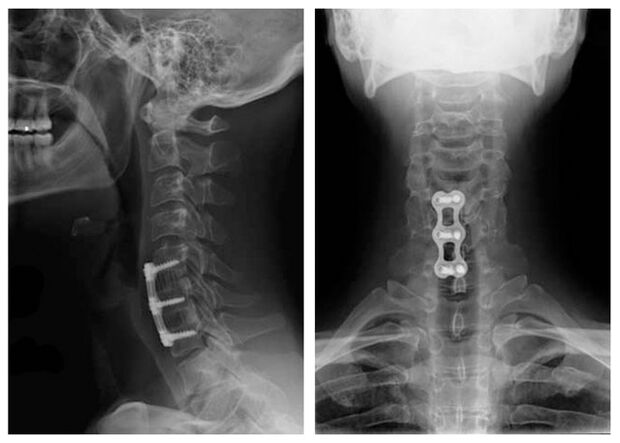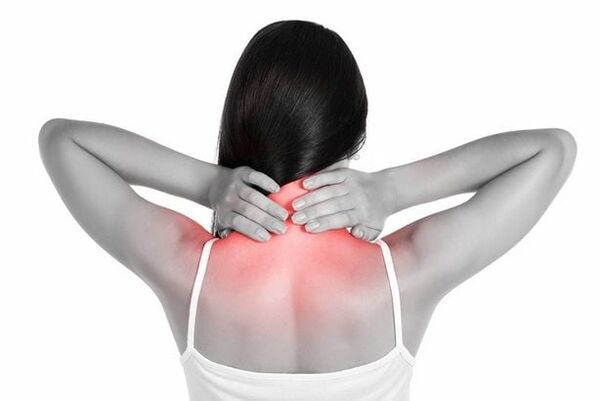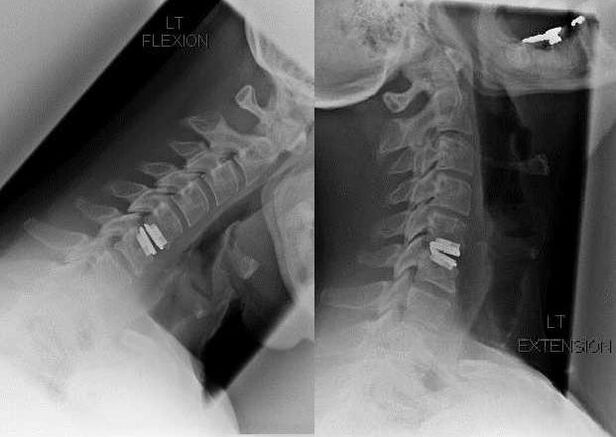The cervical area of the spine is subjected to increased loads that the cervical muscles try to lead to balance during the influence of the above sources. This causes the appearance of muscle spasm, which is why there is a violation of blood transport throughout the body. As a result, the formation of anatomical damage is noted.

- A sedentary lifestyle.
- Work associated with long monotonous movements.
- Sport as a heavy physical tension.
Osteochondrosis, a disease of the century and this is the cause, and the rest is a more likely consequence leading to the development of the disease. The manifestations of the disease are varied and at the first visit to a neuropathologist it is not always possible to make an accurate diagnosis. In any case, after feeling malaise and the first symptoms, we visit the radiculitis doctor. Diagnosis and start treatment based on the results of the study. At the early stage, to cure, possibly any pathology. Osteochondrosis of the cervical region is a chronic, slowly progressive spinal disease, in which the vertebrae, intervertebral joints and discs are affected and destroyed. The vertebrae from the first to the seventh who belong to the cervical region suffer. As the disease progresses, the intervertebral discs lose their elasticity and strength, flattened, relaxed, their shock absorbing properties worsen. Such deformation occurs due to changes caused by force disorders and tissue depletion. These disorders are one of the natural processes of aging of the body, but various overloads, posture disorders, injuries, congenital anomalies of the spine, and some other causes cause early cartilage and discs. More and more young people are choosing a stuck job. The lack of properly organized regular loads leads to the weakening of the muscles that fix the spine, a decrease in metabolism and blood circulation in the intervertebral spaces. As a result of a single physical activity, the pinching of the spinal nerves may occur or intervertebral hernia may form. Spinal deformation (lordosis, kyphosis, scoliosis) is one of the reasons for osteochondrosis
- excessive physical activity in sports or heavy physical labor;
- hereditary predisposition;
- neck hypothermia (walking in winter without a scarf);
- stress;
- work on the computer;
- Obesity.
Some of the above causes cause osteochondrosis and other spine. Cervical osteochondrosis develops with excessive loading of this part of the spine. The neck muscles try to reduce it, leading to spasm, blood disorders and as a result of degenerative processes in the spine. This disease is dangerous as the spinal artery passes near the area of the lesion that feeds the brain. With the displacement of the discs, the growth of fibrous tissue occurs the functioning of the blood vessels. For the successful treatment of osteochondrosis of the cervical region, it is first necessary to determine the cause of the occurrence, the prerequisites that provoked its development and eliminate them. Until recently, the disease was found only in people 45 years of age. Now young people are 18-25 years old. The main causes and prerequisites for the onset of cervical vertebra osteochondrosis are:
- Disruption of stand in young or adolescence.
- Excess weight, obesity of different degrees. Suspended pounds increase the load on the vertebrae and disks, leading to degenerative processes.
- Returning the spine, scoliosis.
- Back injuries that may have happened in childhood or adolescence.
- Disruption of metabolic processes.
- A work related to physical labor that can provoke diseases of the spine in different departments.
- A cheap lifestyle, sitting work, improper performance of any exercise.

- Stress, nerve loads adversely affect the general condition of the body, can cause cervical osteochondrosis.
- Transferred infectious diseases often become the root cause.
- The wrong, uncomfortable position of the body during sleep (such as an uncomfortable pillow).
- Congenital problems or the presence of hereditary diseases.
The main cause of the disease is a sedentary lifestyle, which causes nutrients to "stagnate" and do not reach the destination-spine. However, there are others:
- Lack of physical activity and sports as a result of this slightly developed muscular corset
- Excessive physical activity
- Smoking and abuse of alcohol
- abuse of too fat and salty foods, "fast" carbohydrates
- Excess weight
- heredity
- common or other injuries
- Initially curved stand
- Transferred infectious diseases with spinal complications
- Natural aging of the body
The main causes of cervical osteochondrosis are a sedentary lifestyle. Pathologies are the most susceptible to drivers, office workers, lovers to sit near the monitor screens. Due to the constant stuck image and with a lack of exercise, they can:
- There are disorders of metabolic processes;
- deposition of salts in the liver, kidneys, neck;
- The degree of salts in the lymphatic fluid, as well as blood flow, increases.
The vertebral disorders are provoked by the lack of nutrients from the inter-(periodic disc. Also, the possible causes of cervical osteochondrosis are unbalanced, malnutrition. The most common factors for osteochondrosis of the cervical spine.
- excess weight, hormonal imbalance;
- strong physical activity, heavy for the human body;
- genetic predisposition;
- constant stress, nervous tension;
- Stand damage (rheumatism, scoliosis, etc. );
- trauma to the neck of the neck, spine;
- Anomalies in the development of neck departments, flat legs;
- body hypothermia;
- Age -related changes;
- Sports activity.
Many of the above factors form the load on the vertebrae of the neck, which is why muscle spasm occurs. As a result, blood disorders are manifested, metabolic processes decrease and this leads to degenerative abnormalities. Sometimes with cervical osteochondrosis, the cause of the formation can be a developing disk that is transmitted to bone tissue and closing the vertebrae. It often occurs with prolonged physical activity.
Methods to prevent the disease
Osteochondrosis is a recurrent degenerative-dystrophic pathology that takes place against the background of the gradual destruction of intervertebral discs and bone deformity. It is necessary to exclude from the usual lifestyle factors that provoke the worsening of cartilage trophies. It is low motor activity, excess weight, excessive physical activity, deficiency in the diet of products high in trace elements, vitamins.
The progressive, osteochondrosis of the cervical vertebrae passes some stages that are classified by various symptoms. Distinguish 4 stages of pathology development:

- In general, the first stage of the disease is noticed the unexplained smoothing of the cervical bend (lordosis). The clinical manifestation is insignificant, not severe neck pain, can be observed, exacerbated by head turns as well as muscle tension. This stage is treated without medication, the main thing is to change nutrition, to do exercises, etc.
- There is an instability between the vertebrae, their displacement, Turia. The patient has more cheerful pain, hands, hands. The height of the discs becomes smaller, so there is a nerve disorder. The patient experiences fatigue, headache, working ability, declines in inattention.
- There is a decrease in the height of the intervertebral discs, the narrowing of the holes, and the hernia begins to form. Neck and shoulders pain increase, the muscles of the hands weaken, numbness, malaise, dizziness occurs. The diagnosis determines the poor mobility of the neck.
- In 4 stages there is a disk destruction, they are replaced by connective tissue. Such electricity hurts several sections of the ridge, which are at different stages of the violation. In humans, coordination, pain, dizziness increases, tinnitus, etc. may occur.
The signs of the disease in the neck are significantly different from the symptoms of osteochondrosis in another area of the spine. As the cervical vertebrae are located near, the nerve roots and the spinal cord are pressed. This leads to the appearance of such signs:
- The pain syndrome is localized in the neck, nape, shoulders, arms and legs. During joining the nerve receptors, the appearance of uncomfortable sensations in the shoulder area, the back of the head, the arms begin to recover. Due to the spasm in the cervical muscles, the bloodstream is impaired.
- The appearance of weakness in the upper limbs is noted, associated with damage to the functionality of the roots, which contribute to the involvement of the motor nerves, which restore muscle tissue in the hands.
- The upper limbs are restored due to a decrease in sensitivity in them, the root disorders in which the sensitive nerve endings are located.
- When you turn your head, painful sensations appear, you can also hear a crunch. This is explained by the damage in the small joints of the cervical region, a decrease in the level of the intervertebral discs.
- The patient complains of insufficient strength, fatigue, dizziness, coordination disorders. Due to the displacement of the elements of the spine, the spinal artery is squeezed. Therefore, blood circulation worsens, leading to a weakening of the blood supply to the back and the brain.
- The appearance of vision problems, the loss of sensitivity of the language is noted.
Symptoms of cervical osteochondrosis in women do not differ from signs in men. Women who are 45 years old and adults who have been diagnosed with such a disease are numbered and tingling in the upper limbs of a dream.
Methods for the treatment of cervical osteochondrosis
The main signs of osteochondrosis of the cervical region include:
- Pain in the back of the head, neck, arm and shoulder, which are enhanced by sneezing, coughing and minimal load on the arm;
- burning between shoulder blades, numbness in the legs or arms, numbness;
- Pain and crunch in the neck that appear during tilting and turns of the head;
- fatigue, weakness;
- seizures and dizziness resulting from sharp turns of the head;
- The headache, which usually begins at the back of the head, spreads to the temples and the crown.
Other signs of cervical osteochondrosis include tinnitus, hearing impairment and reduction of visual acuity. Sometimes the disease is felt by pulling pain in the heart. At the first signs of cervical osteochondrosis, consult a doctor who will make a comprehensive examination will make a diagnosis. In this case, such diagnostic methods as MRI, laboratory tests, ultrasound, ECG can be used. Like Shantsa collars - are elastic with plastic or metal inserts, gesture, inflatable. The devices vary in height, degree of fixation and design of fasteners. It all depends on the neglect, the characteristic symptoms of pinching of the radicular nerve, as well as other factors. How to cure cervical osteochondrosis or reduce its manifestation with medicines:

- Non -steroidal anti -inflammatory drugs. Medicines relieve swelling, pain, relieve the patient's condition.
- Vitamins B C osteochondrosis of the cervical region. They contribute to the acceleration of metabolic processes in soft tissues.
- Recovery stimulants. They help to repair cartilage tissue even in a damaged disk.
- A group of medicines that help relieve muscle cramps.
- Anesthesia.
Cervical osteochondrosis is treated with conservative methods and treatment is always exhaustive. Drug therapy is the same for osteochondrosis of each department: use medicines from certain pharmacological groups, but the choice of specific drugs from these groups, the dose, the duration of administration is chosen individually for each patient. The photo of the X -Ray of the cervical spine after surgical treatment of the vertebrae of the C5 - C7 is complemented by temporarily wearing the collar of Chanstz or its varieties. Due to the fixation of the cervical vertebrae, the osteochondrosis of the cervical region is treated more quickly. This additional orthopedic device helps to cope with the pain, normalizes blood flow through the vessels of the neck and improves the general condition of the patient.
The severity of the symptoms of cervical osteochondrosis depends on the degree of destruction of vertebrae structures. Symptoms worsen with bone growth with osteophyte formation, radicular syndrome (root pain when pinching the nerve), intervertebral hernia (convexity of the disc in the spinal canal). The first signs of the disease are a periodic headache in the neck, neck soreness, crunching and clicking in the vertebrae when the head is rotated, sometimes slight tingling shoulders. Over time, the symptoms grow and the intensity of pain increases. It is difficult to lift the hand from the side of the lesion - there is immediately a shot in the shoulder or neck. Restricting head movements due to pain often occurs in the morning after sleep in an uncomfortable position. The disease leads to the pressure of the roots of the peripheral nerves (Roying syndrome) and causes pain on these nerves. It is possible to tingle the hands or fingers, a violation of the sensitivity of certain skin areas innervated by a pressed nerve.


















